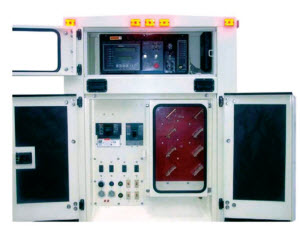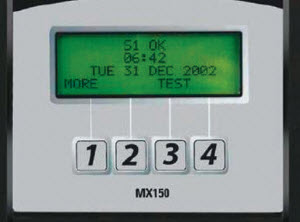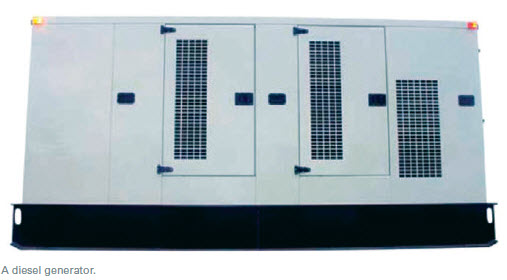by Darren Dembski and Sarah F. Escalante — Last issue, we began our discussion of what is necessary to ensure the reliability of your company’s standby power system by addressing two key issues: The importance of possessing a comprehensive understanding of the power equipment being utilized; and the benefits of an established baseline set of values that can be referenced during routine and ongoing maintenance. We finished off Part 1 with a detailed look at several common reasons for generator start-failure. Reasons 1-3 we listed as battery failure, low coolant level alarms/shutdown and low coolant temp alarms. Reasons 4-10 are addressed below, followed by a closing section on the power of sticking to a preventive maintenance plan.
|
|
| The controller monitors all the engine and generator functions, such as the engine speed for hertz, oil pressure and water temperature. Graphics courtesy of Peterson Power Systems. |
4. Leaks Oil, Fuel, or Coolant. Leaks can be prevented by routine maintenance planning. Most often oil leaks are not, in fact, leaks, but the result of “wet stacking” (or “engine slobber”). Wet stacking is the accumulation of carbon particles, unburned fuel, lube oil, condensed water and acids in the exhaust system. It is caused by excessive no load runtime or when the injection tips carbonize and disrupt the fuel spray pattern.
Diesel engine generators are designed to operate with a load, most effectively in the 70-80% range of rated output. When generators operate considerably below the rated output level, the engine can start to over-fuel or wet stack and damage the engine. Diesel generators used for commercial purposes undergo load applications that continuously vary between efficient and low output conditions. In these applications, the generator is often paired with an automatic load bank, which will place a false load on the generator system. This keeps the engine properly loaded and prevents a wet stack condition. When a diesel engine wet stacks, the engine will need to be cleaned up by loading the unit for a few hours and burning off the excess fuel. If a diesel engine generator steadily runs loads considerably below the rated output level, it will wet stack. For this reason, it is important that you are using a generator properly sized and designed for your needs.
Another cause of oil leak complaints is directly related to the crankcase breathers. Most engine crankcase breathers vent directly under the engine. The fumes that come out of the breather contain an oil mist, which can produce a puddle under the engine and coat the generator and radiator with an oil film that collects dirt and debris. Re-circulating breathers are available that can separate the oil and return it to the engine; remaining fumes get returned to the engine air intakes.
The most common coolant leak occurs in the block heater hoses. Extreme temperatures on the outlet make block heaters hard on their hoses. It is for this reason that rubber hoses should never be used for block heaters; silicon hoses are specifically designed for use with block heaters. Isolation ball valves should always be installed for block heater hose connections. Cooling system maintenance will help prevent leaks. Replacement of hoses and coolant every three years is recommended. Generators using newer extended-life coolant should still have hoses replaced and the additive package upgraded every three years. Cooling system anti-freeze protection and conditioner should be maintained to the manufacturer’s specifications. Radiator core damage is directly related to the coolant that is in the system. Poorly maintained coolant will cause liner pitting, and eventually, severe engine damage. Most fuel leak service calls are due to overfilling of the base tank. This is due to either human error or a failure of a pump system. Do not try to manipulate the fuel system into doing something that it is not designed to do. Remote tank pump systems and emergency shut-off systems should be checked periodically for proper functioning. Flexible fuel lines should be checked regularly for cracks and signs of aging.
|
|
| Automatic transfer switch (ATS) control panel inside the front door. |
5. Controls Not in Auto. Ninety-nine percent of service calls received for generator controls “not in auto” are the direct result of human error. The obvious reason for not in auto is the main control switch is left in the off/reset position. This usually occurs after testing or servicing of a generator. After any service is performed on a unit, always double check the generator system yourself. The technician’s feelings will not be hurt by checking his work.
The control switch may have several positions, as in “Off/Reset” and “Cool Down,” which will cause the generator not to start in the event of a power outage. These positions should give an alarm. “Not in auto” is a generic term for the unit not being shut off and may not actually be the main control switch. Alarms not reset, breakers open, switch gear not reset and emergency stop buttons activated are all examples of not in auto failures. Several generators are set up to short trip the main circuit breaker during an emergency fault shutdown. When the generator shuts itself down (for any reason), someone has to physically reset the control panel to clear the alarm. There may be several things to check and reset after a fault shutdown. However, this should only be done once the cause of the alarm has been identified and corrected. Ground fault sensors are required by certain building codes or engineers during construction and must be added onto a generator. These sensors look like light switches that are turned off. Ground fault sensor shutdowns can be difficult to spot; they are not always tied to an audible or visual alarm. It is important that you determine if your standby generator is equipped with one of these sensors and how to reset it. If the generator uses remote switch gear, the switch gear will normally have to be reset. It is important to know your system and what it does during a fault shutdown. Simulate a fault to see what it takes to get it running again in the event of an emergency.
6. Fuel Bled Back Into the Tank/Generator Will Not Start. This is a common problem with newer generators that are not run on a regular basis. Closer tolerances within the fuel systems to meet today’s emission requirements make fuel systems more susceptible to air effecting start-up. This is not as common with older generators. Older generators that experience this problem may have a leak in a line or check valves that are not properly holding the fuel in the engine.
Lighter low-sulfur fuel has a lower flash temperature, which causes the block heater to flash off some of the fuel within the injectors. One small bubble of air within a unit injector solenoid can cause an injector not to fire at start-up. If enough injectors do not fire, the engine will not start. This failure is 100% preventable by periodically running the engine during weekly inspections. The engine does not need to be run until the coolant temp comes to normal. All that is needed is enough time to verify that the engine will start, the air is cleared from the fuel system and the generator comes up to voltage and frequency. This can be completed in less than five minutes. Any additional test running would simply burn up fuel and air quality maintenance run time.
7. Engine Ran Out of Fuel. Mechanical fuel level gauges may not always be accurate. Unlike a vehicle that is moving and using a higher percentage of its tank’s capacity, a generator tank has no movement, causing the fuel to become stagnant. Mechanical gauges may also stick in a position until vibrations break them free.
Low level alarms must also be addressed, as they provide the same failure alarm. Some generators are equipped with “Low Low Level Shutdown” or “Critical Fuel Level Shutdown.” These shutdowns are there to prevent the fuel system from drawing in air when running out of fuel is imminent. Note: This shutdown alarm was not very popular in the Y2K days. If your generator was installed during this time, you may wish to retrofit it, as it most likely will not have this alarm.
Bleeding air out of a fuel tank can be an extremely difficult procedure. Running out of fuel due to plugged fuel filters can be prevented by maintaining the fuel tanks and periodically checking them for water and contaminants. Water or moisture in fuel can be damaging to diesel engines because the water properties create advanced ignition and accelerated detonation. It is also important to build relationships with fuel vendors that you can trust and rely on to deliver clean fuel. If you use fuel polishing as an alternative to cleaning your fuel, check with your vendor to see if their fuel is affected by the chemicals. Fuel polishing may not be able to remove water. Fuel filter plugging should be expected with the new ultra-low-sulfur fuel, which has a very high detergent level and will clean out your lines and whatever else it is in contact with.
Engines equipped with electric shut-off solenoids should always have a manual bypass. There are several reasons to have shut-off solenoids: Large, remote above-ground tanks can gravity feed to the engine, over-pressuring the seals in the pumps or injectors and causing the fuel to mix with the oil. Solenoids should be on DC power, activated at the time of initial crank signal and remain open until after the engine makes a complete stop.
8. High Fuel Level Alarm. High fuel level alarms are required by government regulations to prevent the overfilling of a fuel tank. The alarm should activate when the fuel tank reaches between 90%-95% capacity. This lets the person fueling the tank know when they should stop filling generator when this alarm activates. On rare occasions, the natural thermal expansion of the fuel will cause the alarm to activate. This will usually occur on an extremely hot summer day. High fuel level alarms may or may not clear themselves when the fuel level drops below the set point. You may have to manually reset the alarm when the fuel level drops.
9. Breaker Trip Not Related to the Generator. This service call will usually come in as “We are in a power outage, and the generator doesn’t start.” First, verify that nobody has accidentally pushed a remote emergency power-off switch. If a breaker trips after the automatic transfer switch (ATS), the generator will not start. The status of the automatic transfer switch should be checked during a power outage. The ATS should have some kind of lights or display showing the switch position and source availability. The correct position in which to check a breaker is downstream from the transfer switch. If a breaker is found to be tripped, make sure you can determine the cause of the trip prior to resetting.
|
|
Never try to manually operate an automatic transfer switch if you do not know how to do so properly. Severe bodily injury or immediate death can occur. The transfer switch is smarter than you may think and has a specific reason for being in the position that it is in: Attempting manual operation may drag you into a live bus if it is done incorrectly.
10. “My Generator is Running!” Your company should have an active plan in place when your facility moves to standby power. A well-maintained emergency or standby power system will operate completely on its own without any user intervention. The system needs to be able to do its job. After a local power outage, many service calls come in stating that “utility power is back on and the generator is still on.” There are a couple of reasons for this. One reason is a delay timer in the automatic transfer switch that will keep the generator online until the automatic transfer switch sees a steady supply of clean power coming from the utility grid. This timer is usually set between 15 and 30 minutes. Any glitch in power within that time will restart the timer.
Another reason the generator will stay online is the In Phase Monitor. The automatic transfer switch may be set to have the phase angle of the generator match the phase angle of the utility grid prior to retransfer. If an In Phase Monitor is used, never set the generator frequency to exactly 60.0 Hz. If the generator and the utility are both at exactly the same frequency, the generator may take an extremely long time to match phases.
The Power of Sticking to a Preventive Maintenance Plan A standby power system requires routine maintenance to guarantee power security. Writes Tim Gorman, “Your generator is your only line of defense when [your facility] loses power. A generator usually doesn’t have a backup. A lack of generator maintenance will result in generator failure.” Efficient performance is dependent on regularly scheduled maintenance. The normal maintenance requirements for a diesel generator are about the same as the requirements for a diesel engine vehicle: checking oil, oil filters, air filters and fuel filters. Standby generator engines need an oil change annually, or every 100 to 250 hours, depending on the environment in which the unit will be located. The oil filter should be changed every time the oil is changed. Air filters need to be changed in accordance with the environment; diesel generators need a lot of clean air to operate properly and will suctioncollapse an air filter if it is allowed to get too dirty. It is recommended that you check the air filter every 100 hours and more frequently in dustier environments. Fuel filters should be changed every 200 to 250 hours depending on environment conditions and how clean the fuel is.
“Generators should be exercised monthly at 30% of the nameplate rating or loaded to the minimum engine exhaust temperature recommended by the engine manufacturer” (Consulting-Specifying Engineer magazine, May 2005). Automatic transfer switches can be programmed to automatically start-up and run the standby system at predetermined times.
Your standby power system will be a long-term investment if properly sized and designed to handle your facility or application load requirements. It is important to remember that a generator is a mechanical and electrical device that will require service and parts to maintain proper functioning. Understanding how your standby system operates and dedicating time to maintenance today will save your company the stress and cost of power problems in the future. When it comes to standby continuous power, there are two essential influences on the reliability of your company to stay operational: how well you know your particular system and how well you stick to a scheduled preventive maintenance plan.FEJ
References
Dembski, Darren. “Top Ten Reasons Why Generators Don’t Start (And What You Can Do About Them),” presented at the Northern California Facilities Solutions for Engineering Engineer Show, September 21, 2006. Johnstad, Kai and Matt LePard. Essential Standby Generator System Requirements for Next Generation Data Centers. White Paper #90, American Power Conversion, 2005.
Lane, Keith. Power Quality and Generators Part 7: Commissioning, Training and Long-Term O&M Programs. Seattle: Engineering, SASCO, 2005. (View it online at www.csemag.com/article/CA602440.html). Norman, Tim. “Generator and Transfer Switch Maintenance.” The University of Delaware: Applied Poultry Engineering News, Vol.2 No. 2, April 2004.
ONLINE
www.batterystuff.com/tutorial_battery.html
www.ibsa.com/www/faqs/tech_talk/terms/s.htm
Darren Dembski is the product support sales representative
covering the Silicon Valley area for Peterson
Power Systems, the Northern California dealership
for Caterpillar power equipment. Before serving in
this position, Dembski worked for nine years as a
fi eld serviceman focusing primarily on generators. He
started his diesel engine career in over-the-road truck
engineering. Dembski has an A.S. degree in automotive
and diesel technology from the Universal Technical
Institute in Phoenix, AZ.
Sarah F. Escalante is the Power rental administrative
assistant and staff writer for Peterson Power
Systems, focusing primarily on generators and business
contingency planning. She is also the co-author
of “Contingency Planning for Disrupted Electric
Power: The Case for Partnering with a Strong Rental
Power Supplier.” Previously, Escalante worked as an
editorial assistant at the academic journal Critical
Inquiry. She received an A.B. in philosophy from The
University of Chicago.


